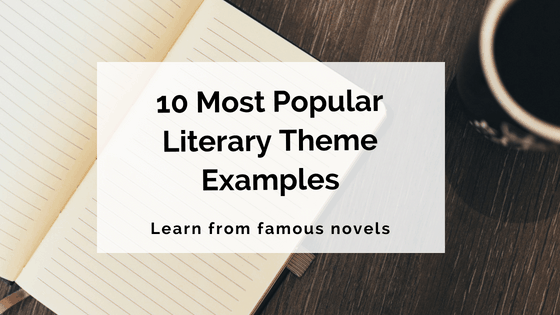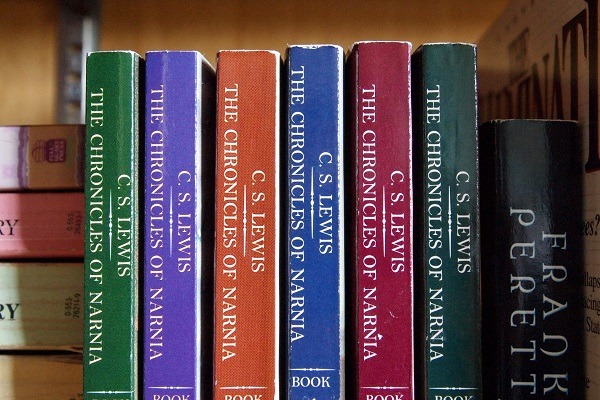Theme in literature is a topic we’ve delved into before. Every story has themes – whether they’re consciously explored or simmering under the surface – and the exploration of different themes adds depth and layers to any story, especially if those themes are universal.

So today we’re taking a look at some of the most popular themes explored in the world of books, through some specific literary theme examples.
From broad, sweeping concepts, like love or death, to more particular ideas, like coming of age or good vs. evil, we’ll cover a wide range of the most common themes and the books that explore them.
Here goes!
Don’t have time to read the whole post right now?
No problem. Let us send you a downloadable PDF so you can read it when it’s convenient for you…
1. Love
It shouldn’t come as a surprise that the number one spot on our list goes to the theme of love.
One of the most popular topics covered not only in books, but in movies and music as well, love is a universal, multi-faceted theme that’s been explored in a number of ways throughout the history of literature.
First love, lost love, forbidden love, unrequited love; the love between partners, between parents and children, between siblings, between friends; the power of love to conquer all…
You name it – if it’s got anything to do with love, it’s a theme that’s been explored in multiple books.
So what are some different love theme examples in literature?
- Shakespeare’s Romeo and Juliet is obviously one of the first stories that comes to mind – a tragic tale of forbidden love with terrible consequences.
- Pride and Prejudice by Jane Austen is another classic example, exploring the type of love that grows slowly, where there has once been dislike and misunderstanding.
- Wuthering Heights by Emily Brontë explores love in a different light, highlighting the ways its intensity has the power to disrupt and even destroy lives.
- One of the key focuses of R. J. Palacio’s Wonder is the unconditional, fierce love between family, especially parents and children.

2. Death
Coming in at a close second is another of life and literature’s universal themes: death.
You’ll be hard-pressed to find many books that don’t deal with death in some way or another. Whether it’s an exploration of grief after the loss of a loved one, an existential musing on the nature of the life-and-death cycle, or a question about what, if anything, comes ‘after’, death is a popular topic across many genres.
Stay up to date with the most popular posts on Writer’s Edit.
Here are some examples of books that explore this theme:
- The Book Thief by Markus Zusak is, in fact, narrated by Death himself, exploring the nature of his role in taking human lives against the backdrop of WWII Germany.
- In The Lovely Bones, Alice Sebold explores death through another unusual perspective: that of a girl who has recently been murdered, and who watches over her family in a sort of limbo state while trying to come to terms with her own death.
- The Fault in Our Stars features teenage characters coming to terms with their mortality in the face of terminal illness.
- J. K. Rowling’s Harry Potter series encompasses many themes (most, if not all of the ones on this list, in fact!). But perhaps the most pervasive theme of the series is death, which is explored constantly from the death of Harry’s parents through to Voldemort’s final attempts to become immortal.

3. Good vs. evil
The battle between good and evil is a theme that’s particularly common in fantasy series.
It doesn’t need much explaining; books that explore this theme generally feature a battle between good and evil, in which good usually (but not always) triumphs.
Some books featuring a good vs. evil theme:
- The Lord of the Rings by J. R. R. Tolkien pits good quite clearly against evil in its tale of hobbits, elves and men teaming up to defeat the power-hungry Sauron and his armies of dark creatures.
- George R. R. Martin’s A Song of Ice and Fire series explores every nuance of the concepts of ‘good’ and ‘evil’, from the portrayal of morally grey characters through to the battle with the story’s overarching villains, the White Walkers.
- The Chronicles of Narnia, C. S. Lewis’ magnum opus, follows four siblings who pass into an entirely new world, in which they encounter characters both good (e.g. Aslan) and evil (e.g. the White Witch).
- Stephen King’s post-apocalyptic novel The Stand also features the light-vs-dark dichotomy, staging a battle between good and evil through the characters of Mother Abagail and Randall Flagg.

Essential Reading
9 Fiction Genres You Should Know About
4. Coming of age
Popular not only in children’s and young adult books, but also adult literature as well, coming of age is a commonly explored theme.
Stories that feature this theme tend to deal with experiences in a young character’s life that lead to a loss of innocence and/or a fundamental change in their mindset and outlook on life.
Some coming of age theme examples:
- The Catcher in the Rye by J. D. Salinger follows Holden Caulfield, a sixteen-year-old boy dealing with teenage angst and rebellion in the 1950s.
- Louisa May Alcott’s classic Little Women chronicles four sisters’ journeys from childhood to womanhood in 19th century Massachusetts.
- A Tree Grows in Brooklyn by Betty Smith is the turn-of-the-century coming of age story of Francie Nolan, who learns the realities of life while growing up in the slums of Williamsburg.
- Stephen Chbosky’s The Perks of Being a Wallflower is the story of teenage Charlie navigating all the challenges that come with the time between adolescence and adulthood.

5. Power and corruption
Power and corruption are two concepts that go hand-in-hand, and are explored as a unified theme across many genres.
Power is explored in literature on many different levels, from power over other people through to power over life or death itself. And with any type of power comes the potential for corruption, often explored as misuse of power, or the lengths to which someone will go to achieve it.
Some common examples of the power and corruption theme:
- Shakespeare’s Macbeth is the tragic tale of the title character seeking power for its own sake, and dealing with the consequences of his own ambition.
- Animal Farm by George Orwell is another classic exploration of the theme, an allegorical story about a group of animals who rise up against their human masters – with increasingly sinister results.
- The Hunger Games series by Suzanne Collins features a dystopian society with a totalitarian government that uses its power to mistreat, manipulate and even murder its citizens.
- It’s the second time we’ll mention The Lord of the Rings on this list, but its exploration of power and corruption is too central to its story to be left out! The artefact at its heart is literally called the ‘Ring of Power’, after all, and it was designed by Sauron specifically to corrupt those who wield it.

6. Survival
All creatures share the same basic instinct for survival, so it’s no surprise that this is a common theme throughout literature. In recent years, the surge in popularity of the dystopian genre has made this theme even more prevalent.
Books exploring the theme of survival usually pit characters against an external force such as the environment, a disease or a powerful antagonist.
Here are some survival theme examples across a few different genres…
- Lord of the Flies by William Golding focuses on a group of young boys stranded on a deserted island, chronicling their attempts to survive and govern themselves.
- Yann Martel’s Life of Pi is the story of a boy’s attempts to survive after a shipwreck, stranded on a boat in the middle of the Pacific Ocean.
- Room by Emma Donoghue tells a different story of survival: that of a woman who has been kidnapped and held captive for seven years, and her five-year-old son, who has never known life outside the room they live in.
- Cormac McCarthy’s The Road is a bleak dystopian exploration of the relationship between a man and his son as they struggle to survive in a harsh and unforgiving environment.

7. Courage and heroism
Tales of heroism and courage in the face of adversity have been popular for hundreds, if not thousands of years. In fact, one of the most widely used story structures in the world is something called the hero’s journey.
This theme can be explored in different ways and on different scales, but perhaps the most common are ‘traditional’ hero stories about characters who are essentially destined for greatness, and, on the flipside, stories about ‘unlikely’ heroes who achieve greatness despite the odds.
Well-known examples of this literary theme include:
- Tolkien’s The Hobbit tells the tale of unlikely hero Bilbo Baggins, who musters his courage and leaves his quiet life as a homely hobbit to undertake an important quest.
- Rick Riordan’s Percy Jackson series follows the title character, whose father is the god Poseidon, on a series of heroic adventures, fighting mythological monsters and defeating dark forces.
- Robin Hood, a character from English folklore, is famous for his acts of heroism – namely, stealing from the rich and giving to the poor.
- Beowulf, the Old English epic poem by an anonymous author, tells the story of the title character, a hero who defeats monsters and villains in three different battles.

8. Prejudice
A theme that is all too present in the world today, prejudice is also frequently explored throughout literature.
Tales of characters overcoming their prejudice and changing their way of thinking for the better are common, but so are explorations of the destructive consequences prejudice and hasty judgement can have.
Some examples of books about prejudice:
- To Kill a Mockingbird by Harper Lee is one of the most famous explorations of prejudice and racism: white lawyer Atticus Finch is appointed to defend Tom Robinson, a black man falsely accused of the crime of rape.
- We’ve already mentioned this one, but we couldn’t help but bring it in again – after all, it’s right there in the title! Jane Austen’s Pride and Prejudice tells a love story based around mistaken first impressions and judgements.
- The Hate U Give by Angie Thomas explores the pertinent issue of institutionalised racism and prejudice through the story of Starr Carter, who witnesses the fatal shooting of her (black and unarmed) best friend by a police officer.
- Mary Shelley’s Frankenstein explores prejudice and fear of the unknown through the story of Dr. Frankenstein and the ‘monster’ he creates.

9. Individual vs. society
Stories with this theme revolves around a main character who is something of an outsider, at odds with the society they live in.
They’re different from most, if not all of the people around them, and they usually either struggle to fit in with society’s expectations or rebel against them (sometimes both). This theme is especially popular in dystopian fiction.
‘Individual vs. society’ theme examples include the following:
- Nineteen Eighty-Four by George Orwell, perhaps the most famous dystopian novel in the world, follows protagonist Winston Smith as he rebels against an oppressive government.
- Huckleberry Finn features a title character who finds it hard to fit into society, so runs away from home to have his own adventures.
- The Giver, a YA dystopian series by Lois Lowry, is the story of a boy named Jonas who grows up ‘different’ in a society founded on ‘sameness’.
- Ray Bradbury’s Fahrenheit 451 features a society in which books are not only banned, but burned, following protagonist and ‘fireman’ Guy Montag as he decides to start saving books instead.

10. War
Our final theme is one that’s been relevant for thousands of years: war.
From historical novels exposing the horrors of real-world wars, to speculative fiction stories featuring epic battles between fantastical characters, war is portrayed consistently throughout the history of literature.
Some famous books exploring this theme:
- Set during WWI, Ernest Hemingway’s A Farewell to Arms follows Lieutenant Frederic Henry’s attempts to leave the horrors of war behind.
- War and Peace by Leo Tolstoy has war as one of its main focuses; specifically, Napoleon’s invasion of Russia and its impact on five Russian families.
- Slaughterhouse Five is written by war veteran Kurt Vonnegut, and has been called an ‘anti-war’ novel due to its exploration of the destructiveness of World War II, particularly the firebombing of Dresden.
- Margaret Mitchell’s classic Gone with the Wind is set in Georgia and Atlanta and follows the spoiled daughter of a plantation owner during the American Civil War.

***
We hope you’ve found our list of literary theme examples useful! Feel free to share your own examples for these themes in the comments.
30 responses to “10 Most Popular Literary Theme Examples”
Thank you, Claire. Yes, I did find your list of literary theme examples useful. Simplifying, clarifying.
Keeping me ‘on track’.
You’re most welcome, Carolyn! Glad to hear you found the article helpful. 🙂
Ok beautiful
This was really useful for homework, I wasn’t sure what it meant by themes and what they are thank you 🙂
this thing helped me a lot with my school homework! thanks a lot you guys! 🙂
Thanks, this was really helpful
You’re welcome, Mango!
Then you Claire this was really helpful with my homework. I am only in 8th grade and I am doing English 1 so yeah.
You’re very welcome, Jersey! Best of luck with your English homework 🙂
Thanks,!I am writing a book, and had a story with no theme, so….. thanks a lot on the great ideas.
You’re welcome, Owen! All the best with your writing 🙂
Your list was really helpful. BYE!!
Glad to be of use, Casey!
Thank you!
I was having trouble on my English homework and this helped a lot! Happy holidays
You’re welcome, Jay! Happy holidays to you too 🙂
This list was way more descriptive than what I thought it was going to be like. I find it quite fascinating that there are people that care about writing, and not video games.
After all, being a twelve-year-old really means a lot, especially when you’ve spent three years now writing whenever you possibly can. I’ve achieved Hand Writing, not typing, 500 pages since 2 20 2016.
My teacher, from sixth grade, I owe it all to him.
Is it okay if I use 2 themes in one story?. Like love and good vrs. evil?
Yes, that is fine, it just has to make sense.
Thanks a million, Claire! Good job! Lots of ideas popped into my mind.
Straight to the point. Thanks Mam for such detailed guide.
thank you this is really helpful for a book
Of course it is a lot of famous and popular books have multiple themes and I don’t see why you can’t use two themes.
Thanks the themes helped me a lot with my reading work,by the way i’m in 6th grade.
Thank you! This article really helps me since I’m working on an essay in English. Thank you so much! <3
Thank you Claire! This really helped me in my language arts self paced unit. Again thank you ????
Thank you so much, I found this a lot more helpful than other websites. How many ideas on this list do you think are appropriate for one (short) story/ creative writing piece?
Again, thank you.
Thank you! This is by far the most inclusive and specific when it comes to expounding the literary themes, the examples and how it works in writing. This is very helpful!
I learned alot form this website and it has made me improve my english skills.
It was very useful in my classroom
I am using a different theme then on this list but it helped my start thinking. Thanks!